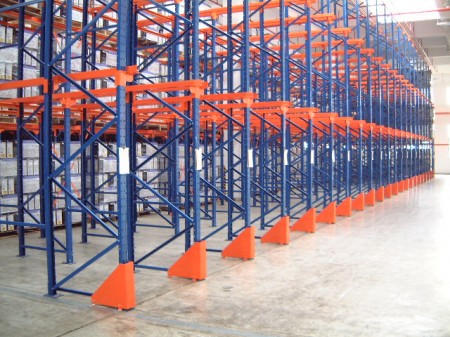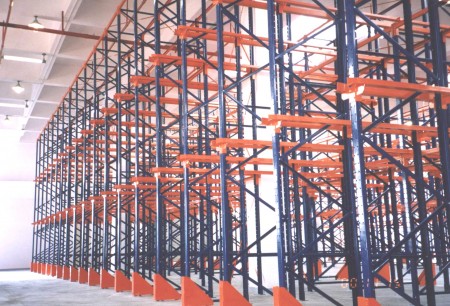Drive in and drive through racking is a type of pallet rack storage systems, it can deploy different guide rails depending on practical and operate assist by aisle stacker or other carry machines. This kind of pallet racking systems is perfect for storage item in less variety, for it increases the pallet racking depth in order to maximize industrial rack storage capacity, which also makes it become FIFO warehouse shelving solutions.

Required information before drive in racking system designed:
1. Weight of the warehouse pallet. The weight of each pallet is the key factor to decide what material to choose and what specification to make.
2. Size of drive through racking pallets. Size of pallets and cargo can determine the size of drive through racking system.
3. Lifting height of forklift and usable clear height of the rack warehouse. These data will decide the height of drive in drive through racking system. But consider the stability of drive through racking system is weak compared with all other pallet racking systems, it’s suggest that don’t design it too high.
4. Forklift entering direction. Above article has mentioned that this kind of rack shelving systems can only fetch in one directly, that determine the direction of drive in rack.
5. Shelf racking storage area size. The warehouse racking layout and channel design will decided by industrial rack storage area planning, it’s also the prerequisite of cargo fetching in the future.
6. Stock removal direction and requirement.

Daily maintenance after drive in racking installation and during usage:
1. Routine inspection for connection of drive in racking bolts, especially those in a high position. There must have some pressure and collision during shelf racking storage.
2. Routine inspection for connection between beams and upright post. Friction occurs in this position where the need to pay much attention.
3. Routine inspection to check whether it has any deformation and assure guide rails leveling. The completeness of guide rails is very important, for it’s where to loading cargoes.
4. Routine pallet racking inspections for stub arm deformation degree and check if there’s any crack. Stub arm is also the parts that bearing high-pressure need to maintain in good condition.
5. Routine inspection for drive in drive through racking stability. Inspectors can stand on upper parts of the cold storage racks and shake to check the stability.
6. Routine inspection for perpendicularity degree. Ensure there’s no any incline happen.
Post time: 06-11-2018





